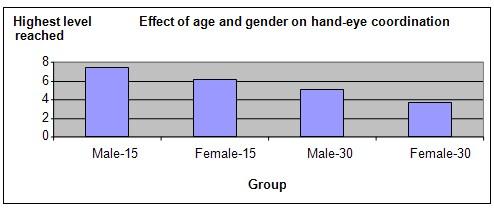| Complexity level: | 4 |
| Time required: | Preparation will take approximately one day, and observation and recording of data will require one more day. |
| Material availability: | Easily found |
| Safety concerns: | None |
Hypothesis
Teenagers will have better hand-eye coordination than adults.
Overview
Hand-eye coordination
Hand-eye coordination refers to the coordination between our eyes and our hands when accomplishing a particular task. We use it everyday to perform simple jobs such as making a cup of tea, writing, playing games or driving to work. Hand-eye coordination is also involved when we catch a ball thrown towards us or pick up a book from the table.
Coordination is achieved by first using our eyes to gather information necessary to accomplish a particular task, after which the brain will process and analyze the gathered information before sending signals via our nervous system to the muscles located in our hands. Our hand muscles will then either contract or expand depending on the stimuli, and this results in the hand and finger movements that are necessary to accomplish the desired task.
Hand-eye coordination is essential for our survival. Without it, we would not be able to avert dangers such as avoiding a falling object, or to perform tasks such as building homes, hunting for food, harvesting crops and acquiring new skills while working.
Scientific Terms
Materials
Materials required for this science fair project:
- 10 boys and 10 girls age 15
- 10 men and 10 women age 30
- 1 computer game with 20 levels (try something fairly simple to play - for example, a shoot' em up)
- 1 computer
- 1 quiet room
Procedure
1. The independent variables in this science fair project are the gender and age of the participants. The dependent variable is the highest level reached by the participants in the computer game, which is determined by selecting the highest level after three attempts. The constants (control variables) are the type of computer game chosen, the computer used, and the number of attempts given to the participants.
2. Select participants aged 15 years old and 30 years old, ten for each gender and age, to take part in this study. All 40 participants will be participating in this study one at a time.
3. Install the computer game into the computer and go through the rules of the computer game and necessary keyboard functions for 15 minutes to each participant. Alternatively, you could pick a game from popular flash game websites such as miniclip.com, or just1game.com. For our experiment, we picked Heli-Attack 2. All 40 participants will be given the same instructions.
4. Allow each participant three attempts to reach the highest possible level that they can achieve in the game. Record the highest level out of the three attempts in the table given below.

Results
The 15 year old teenagers were able to reach a higher level in the computer game compared to the 30 year old adults. In addition, male participants within each age group were able to reach a higher level compared to female participants.
| Gender and age | Highest level in computer game reached by the 10 participants of each gender in each age group | Average | |||||||||
| 1 | 2 | 3 | 4 | 5 | 6 | 7 | 8 | 9 | 10 | ||
| Male-15 | 7 | 11 | 12 | 8 | 5 | 14 | 6 | 9 | 8 | 14 | 9.4 |
| Female-15 | 6 | 8 | 10 | 7 | 6 | 12 | 7 | 7 | 9 | 6 | 7.8 |
| Male-30 | 5 | 7 | 6 | 6 | 7 | 5 | 8 | 7 | 6 | 6 | 6.3 |
| Female-30 | 3 | 6 | 4 | 4 | 5 | 3 | 7 | 4 | 5 | 4 | 4.5 |
Use the graph below to plot the experimental data recorded in the table above.
Conclusion
The experimental data and analyzed results support the hypothesis that teenagers possess better hand-eye coordination than adults.
Hand –eye coordination skills are essential for our survival in this world. Without hand-eye coordination skills, we would not be able to accomplish even simple tasks such as buttoning our shirt, picking up a cup from the table or writing a note.
A child usually spends the first few years of life to develop this skill, which promotes independency as they grow older.
Also consider
This science fair project can be also be repeated with the ruler drop test, or by bouncing a ping pong ball and catching it using alternate left and right hands.
Try to repeat the experiment by checking the hand-eye coordination skills using several age groups between 5 to 60 years old to determine the age of peak performance.
References
Hand Eye coordination - Http://en.wikipedia.org/wiki/Eye%E2%80%93hand_coordination
How to improve hand-eye coordination - http://www.bodyomics.com/articles/hand_eye_coordination.html
What is hand eye coordination and how to improve it - http://www.essortment.com/all/whatiscoordina_rahf.htm

